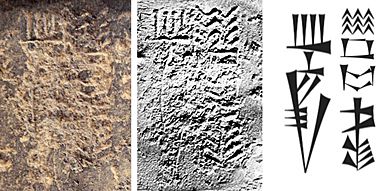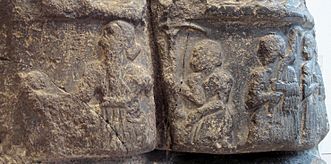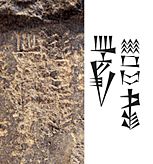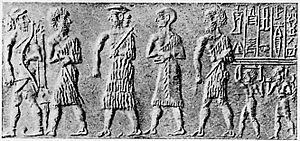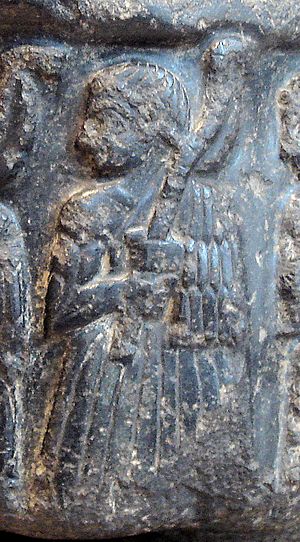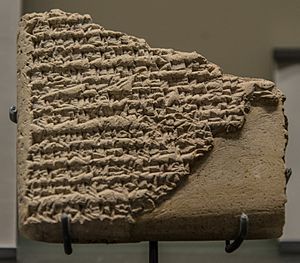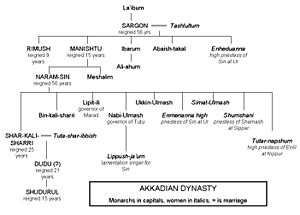Sargon of Akkad facts for kids
Quick facts for kids Sargon of Akkad𒊬𒊒𒄀 |
|
|---|---|
|
|
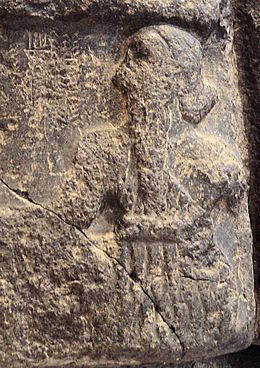
Sargon of Akkad on his victory stele, with inscription "King Sargon" (𒊬𒊒𒄀 𒈗 Šar-ru-gi lugal) vertically inscribed in front of him.
|
|
| King of the Akkadian Empire | |
| Reign | c. 2334–2279 BC (MC) |
| Successor | Rimush |
| Spouse | Tashlultum |
| Issue | Manishtushu, Rimush, Enheduanna, Ibarum, Abaish-Takal |
| Dynasty | Akkadian (Sargonic) |
| Father | La'ibum |
Sargon of Akkad (pronounced SAR-gon), also known as Sargon the Great, was the first ruler of the Akkadian Empire. He is famous for conquering the Sumerian city-states around 2300 BC. Many people consider him the first person in recorded history to rule a large empire.
Sargon started the "Sargonic" or "Old Akkadian" family line. This family ruled for about 100 years after Sargon's death. Their rule ended when the Gutians took over Sumer.
The Sumerian King List says Sargon was a cup-bearer for King Ur-Zababa of Kish. His empire likely covered most of Mesopotamia and parts of the Levant. He also made attacks into areas belonging to the Hurrians and Elam. Sargon ruled from his capital city, Akkad (also called Agade), which archaeologists have not yet found.
Sargon became a legendary figure in later writings, especially in the Neo-Assyrian period (around 8th to 7th centuries BC). Stories about his birth, known as the Sargon Birth Legend, were found on tablets in the Library of Ashurbanipal.
Contents
What's in a Name?
Sargon's name in the Akkadian language is Šarru-ukīn or Šarru-kēn. The first part, šarru, means "king" in Akkadian. The second part, kīnum, means "to confirm" or "to establish."
So, his name could mean "the king has established (stability)" or "the king is legitimate." It's not clear if this was his birth name or a special name he chose when he became king.
The name "Sargon" comes from the Hebrew Bible. It mentions a later king, Sargon II, in the book of Isaiah.
Sargon's Time
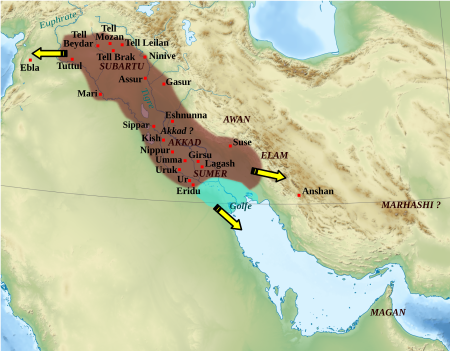
We don't have many original writings from Sargon's time. Most of what we know comes from the Sumerian King List. This list says Sargon was the son of a gardener and a former cup-bearer for King Ur-Zababa of Kish.
The list says Sargon took the kingship from Lugal-zage-si of Uruk. He then moved the capital to his own city of Akkad. Different copies of the king list say he ruled for either 40 or 54-56 years. Historians believe his reign was around 2334–2279 BC. The kings who ruled after him are known as the "Sargonic Dynasty."
Some stories say Sargon built the city of Akkad. However, other writings suggest Akkad might have existed before him. One story says Sargon "built Babylon in front of Akkad." Another says he "dug up the soil of the pit of Babylon, and made a counterpart of Babylon next to Agade." These stories might actually refer to a later king, Sargon II of the Neo-Assyrian Empire.
How We Know About Sargon
Sargon seems to have made the Semitic (Akkadian) more important in official writings. He often called himself "king of Akkad" first, because he founded the city of Akkad. He later took control of Kish and much of Mesopotamia. He called himself "Sargon, king of Akkad, overseer of Inanna, king of Kish, anointed of Anu, king of the land [Mesopotamia], governor (ensi) of Enlil."
During Sargon's rule, the cuneiform writing system, which Sumerians used, was adapted for the Akkadian language. This led to the "Akkadian language" we know today. A special style of writing also developed, where text on clay tablets and cylinder seals was mixed with pictures of myths and rituals.
Historians have found documents that describe four years of Sargon's reign. These documents talk about his military campaigns against Elam, Mari, Simurrum (a Hurrian area), and Uru'a (an Elamite city).
Sargon's Conquests

One important source about Sargon's rule is a tablet found in Nippur. This tablet is a copy of inscriptions from a statue Sargon put in the temple of Enlil.
Sargon allowed the people he conquered to keep their local leaders and traditions. However, they had to follow him and pay a tribute (a payment) for their safety. People in Sargon's empire were loyal to him because his rules helped keep the peace. He also made Akkadian the official language of his government. He also set up standard weights and measurements across his empire.
Sargon conquered lands in Upper Mesopotamia and the Levant, including Mari, Yarmuti, and Ibla. He ruled from the "upper sea" (the Mediterranean Sea) to the "lower sea" (the Persian Gulf).
Sargon also claimed to be "Sargon, king of the world, conqueror of Elam and Parahshum." These were two important areas to the east of Sumer. He defeated 34 cities in total. Ships from distant lands like Meluhha, Magan, and Dilmun came to his capital city of Akkad.
Sargon had a large army or court of 5,400 men who "ate bread daily before him." This shows how powerful and wealthy he was.
Stories of Sargon's Bravery
There are several Babylonian stories, called the "Sargon Epos," that show Sargon as a military leader. In these stories, he asks his advisors for help before going on campaigns.
One story, "Sargon, the Conquering Hero," tells how Sargon encouraged his warriors to be brave. It describes a campaign into a far-off land and the conquest of Simurrum.
Another story, "King of Battle," tells about Sargon's campaign against the city of Purushanda in Anatolia. He went there to protect his merchants. Versions of this story have been found in both Hittite and Akkadian. This story mentions Sargon crossing the "Sea of the West" (the Mediterranean Sea).
Towards the end of his reign, Sargon's empire faced challenges like famine and war.
Sargon's Victories
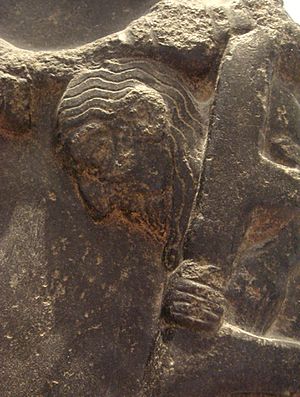
After securing Sumer, Sargon began many campaigns to conquer the entire Fertile Crescent. This is a crescent-shaped region in the Middle East where early civilizations developed.
In the east, Sargon defeated four leaders from Elam. Their cities were looted, and the rulers of Susa, Waraḫše, and nearby areas became loyal to Akkad.
Legends About Sargon's Birth
Sargon became the subject of many legends that described his rise to power from humble beginnings. These stories also told of his conquest of Mesopotamia. Besides these legends, we have some of Sargon's own inscriptions, though most are copies made much later. The Louvre Museum has parts of two victory steles (stone monuments) from Sargon's time.
Sumerian Legend
The Sumerian-language "Sargon legend" tells a legendary story of how Sargon became powerful. This older version of the story was found in Nippur in 1974.
The surviving parts of the story say Sargon's father was La'ibum. Ur-Zababa, the king of Kish, made Sargon his cup-bearer. Soon after, Ur-Zababa asked Sargon about a dream Sargon had. The dream involved the goddess Inanna and Ur-Zababa's death. Frightened, Ur-Zababa ordered Sargon to be killed, but Inanna stopped it. When Sargon returned, the king was scared again. He decided to send Sargon to King Lugal-zage-si of Uruk with a message on a clay tablet asking him to kill Sargon. The story ends here.
This story has parts that are similar to other ancient tales. For example, the dream interpretation is like the biblical story of Joseph. The letter with a death sentence for the messenger is similar to the Greek story of Bellerophon and the biblical story of Uriah.
Birth Legend
A Neo-Assyrian text from the 7th century BC claims to be Sargon's autobiography. It says the great king was the secret son of a priestess. Only the beginning of this text is known from a few fragments.
This "Sargon Birth Legend" has similarities to other ancient stories where a baby is left to be found, like the stories of Moses, Karna, and Oedipus.
Some people have suggested that Sargon might be the inspiration for the biblical figure Nimrod.
Sargon's Family
We know the name of Sargon's main wife, Queen Tashlultum, and some of his children. His daughter Enheduanna was a high priestess of the moon god in Ur. She wrote many religious songs, including her Exaltation of Inanna, which were used for centuries.
Sargon was followed as king by his son Rimush. After Rimush's death, another son, Manishtushu, became king. Manishtushu's son, Naram-Sin, then became king. Sargon had two other known sons, Shu-Enlil (Ibarum) and Ilaba'is-takal (Abaish-Takal).
Sargon's Lasting Impact
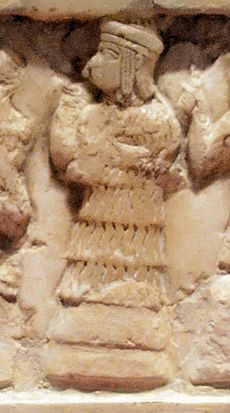
Sargon of Akkad is sometimes seen as the first person in history to rule an empire. An empire is a central government that controls many different groups of people and territories. While other Sumerian rulers like Lugal-zage-si might have similar claims, Sargon's rule marked the beginning of Semitic empires in the Ancient Near East. These empires lasted for about 1500 years.
Mesopotamian kings for about 2,000 years after Sargon looked up to him as a role model. Assyrian and Babylonian kings who built their own empires in Mesopotamia saw themselves as continuing Sargon's legacy. The Neo-Assyrian Sargon Text even has Sargon challenging later rulers to "govern the black-headed people" (meaning the local people of Mesopotamia) just as he did.
Sargon shared his name with two later Mesopotamian kings. Sargon I was an Old Assyrian king likely named after Sargon of Akkad. Sargon II was a Neo-Assyrian king also named after Sargon of Akkad. It is this Sargon II whose name appears as "Sargon" in the Hebrew Bible.
The Neo-Babylonian king Nabonidus was very interested in the history of Sargon's family. He even dug up parts of Sargon's palaces.
Sargon in Pop Culture
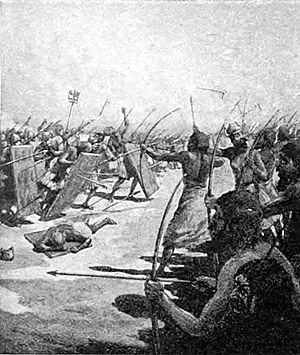
- The movie The Scorpion King: Rise of a Warrior (2008) features Sargon of Akkad as a villain. He is a murderous army commander who uses black magic. Actor Randy Couture played him.
- An episode of Star Trek: The Original Series called "Return to Tomorrow" features an ancient, telepathic alien named Sargon. This character once ruled a powerful empire.
- The American rock band They Might Be Giants mentions Sargon of Akkad in their 2007 song "The Mesopotamians." They also mention Hammurabi, Ashurbanipal, and Gilgamesh.
- Carl Benjamin, a British YouTuber, uses the online name "Sargon of Akkad."
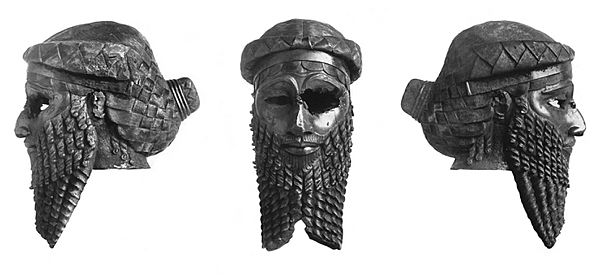
See also
 In Spanish: Sargón I de Acad para niños
In Spanish: Sargón I de Acad para niños
- History of Mesopotamia
- List of kings of Akkad


